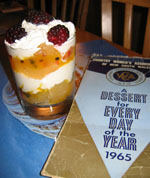 Flummery
Flummery
The in-laws came down to visit last week, and Ma Snook bestowed upon me one of the family heirlooms: a genuine 1965 Country Women’s Association “A Dessert for Every Day of the Year” calendar. (She knew I’d been eyeing one at the 50’s Fair a few months ago, but some woman bought it out from under me while I was deliberating.) This thing is AWESOME. It has desserts that I’ve never heard of using ingredients I’ve never heard of measured in completely archaic units. (I had to look up what a gill equates to.) After having a good flip through, I decided that my first foray into the exciting world of Australian puddings would be the “Fruit Flummery” (January 7, for reference). A flummery, for those not familiar, is a soft, sweet dessert made from thickened fruit. (Think “jam” but a little more bland and wobbly.) This version seemed pretty simple and only had a few ingredients. What I should have realised is that cramming 366 recipes (including one for Leap Day!) into a small calendar means that there’s some serious editing happening. This little recipe – a mere six sentences – left out the fact that this sucker needs to chill for a good six hours or so. So my flummery, which was started on Sunday evening, ended up being our Christmas Eve treat. Here’s the recipe.
1 1/2 cups cold water, 1 small cup sugar, 1 tablespoon powdered gelatine, 1 tablespoon plain flour, mixed to a paste with cold water. Put all in a saucepan; stir till boiling, cook for 3 minutes, put in a basin and allow to cool. Add juice 2 small lemons and 6 passionfruit. Beat till thick and creamy. Serve in glass dish, decorated with cherries.
Looks simple at first, doesn’t it? First hurdle: What’s a “small” cup? I decided to pretend I was a housewife in the bush and I literally just used a small cup. So there I was, mixing gloopy flour paste into a pan of hot clear sugar gelatin and thinking, “What the HELL am I doing?!” I predicted that this was going to be Jellied Ass. After it had “cooked” for 3 minutes, I pulled it out and poured it into a big bowl. Then it went into the fridge. An hour later it was still warm. This is when I realised the recipe was leaving out some vital time information. I went ahead and added the lemon juice at this point, along with a couple chopped up peaches. (Have you SEEN the price of fresh passionfruit these days??) Then back into the fridge. A few hours later, we’d resigned ourselves to not having flummery that night. It had sorta set up around the edges, but it was still pretty much soup in the middle. I was now riddling over the next instruction: “Beat till thick and creamy.” How the hell does clear Jello with fruit in it get thick and creamy? So I plugged in the electric beaters and went to town on it. It actually did get kind of creamy and frothy. Satisfied that I had done my wifely best, I put it back in the fridge for the rest of the night.
Tonight I was ready for some flummery! It was completely set: not as hard as Jello (as I’d feared), and once I’d sorta chopped it up with a spoon, it was nicely soft and squidgy. I decided to make a sort of trifle out of it, layering it with whipped cream (which I whipped MYSELF!) and passionfruit (from a can). We decorated the top with boysenberries. It looked great, but the proof of the pudding… You know. I’m happy to report that it was FANTASTIC. I was seriously expecting it to be bland at best (and NAST at worst), given that it was pretty much just sugar with a tiny bit of flour and gelatine and fruit. Instead we both licked our cups clean. I’m definitely going to score this one as a victory for 1965.
Incidentally, if anybody is interested in seeing a modern, properly written recipe for flummery, I found one here. I only discovered that after I’d done all the work, but I was pleased to see that my guesses (like with the beaters) were correct.
Hmmm, now what shall we try NEXT?

Jen
December 25, 2007 — 12:43 pm
Success! That looks yummo 🙂
Mrs Beeton
December 29, 2007 — 3:36 pm
What you might want to do is track down a copy of “The CWA Cookery Book and Household Hints”, because a) it’s likely to have been the source material for your calendar, and b) they were publishing it from the 1940s right up into the 1990s with most of the recipes essentially unchanged – I think they provide a key somewhere in the later editions that converts their “1 cup”-type measures into actual metric measurements. They’re relatively easy to find in secondhand bookshops, from memory.